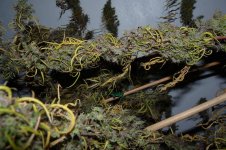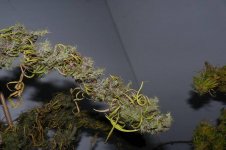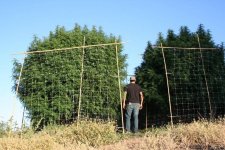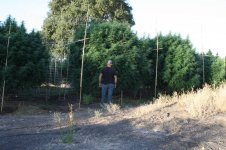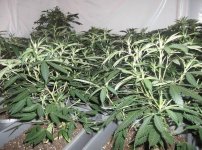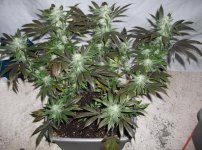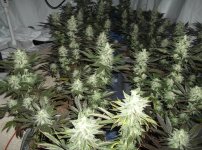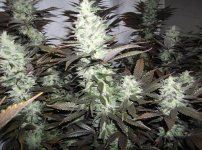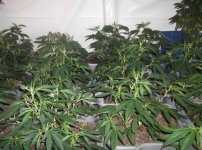-
Happy Birthday ICMag! Been 20 years since Gypsy Nirvana created the forum! We are celebrating with a 4/20 Giveaway and by launching a new Patreon tier called "420club". You can read more here.
-
Important notice: ICMag's T.O.U. has been updated. Please review it here. For your convenience, it is also available in the main forum menu, under 'Quick Links"!
You are using an out of date browser. It may not display this or other websites correctly.
You should upgrade or use an alternative browser.
You should upgrade or use an alternative browser.
Research the term "leaching fraction"...and you will find things like:
When the build-up of soluble salts in the soil becomes or is expected to become excessive, the salts can be leached by applying more water than that needed by the crop during the growing season. This extra water moves at least a portion of the salts below the root zone by deep percolation (leaching). Leaching is the key factor in controlling soluble salts brought in by the irrigation water. Over time, salt removal by leaching must equal or exceed the salt additions from the applied water or salts will build up and eventually reach damaging concentrations. The questions that arise are how much water should be used for leaching and when should leachings be applied?
and....
Leaching is the application of water or fertilizer
solution beyond what can be held by the substrate.
Applying extra water is recommended to thoroughly
wet the substrate, and to remove excess salts from the
substrate. The leaching fraction is the volume of water
that drains from the substrate relative to the volume of
water applied. For example, if you apply 15 fluid
ounces (0.44 liters) of water, and 3 fluid ounces (0.08
liters) comes out of the bottom of the pot then 3 divided
by 15, then times 100 equals a 20% leaching fraction.
In other words, 20% of the water applied to the plant
came out of the bottom of the pot.
It is generally taught that you should have
between a 10% and 20% leaching fraction with every
watering. However, research has shown that leaching is
not necessary for long periods of time if you have a
good water source (RO or rain water is ideal) and the
fertilizer you use does not contain any harmful salts like
sodium or chloride. There are reasons to leach pots,
usually because the fertilizer concentration that is
applied to the crop is too high for the growth rate, or the
water quality is poor, and unused salts (like calcium,
magnesium, or sodium) build up in the substrate. In
general, whether or not you leach should be based on
soil test information showing salt levels actually
building up in the substrate, rather than because
somebody tells you too.
Leaching rates also affect the optimal fertilizer
concentration for your crop. Research has shown that
the same nutrient levels could be maintained in a peat
based substrate if a solution containing 400 ppm
nitrogen were applied with 50% leaching or a solution
containing 100 ppm nitrogen were applied with 0%
leaching. This research also showed that applying a
solution containing 400 ppm nitrogen with 0% leaching
rapidly lead to salts building up in the substrate to
unacceptable levels, while applying a solution
containing 100 ppm nitrogen with 50% leaching lead to
nutrient deficiencies because there wasn’t enough of the
fertilizer remaining in the pot because of the excess
leaching.
Source: staugorchidsociety.org/PDF/IPASubstrates.pdf
Moral of the story: If you normally water with little to zero runoff (dry saucer...no leaching), then big mighty flush(es) before harvest is a must; ahhh, but not necessarily true if your practice is to water with a leaching fraction of 10-20%--something that most organic growers seem to do. You might say, that 10-20% is our "flushing".
BTW, calcium, magnesium & sodium are "organic" salts of sorts.
When the build-up of soluble salts in the soil becomes or is expected to become excessive, the salts can be leached by applying more water than that needed by the crop during the growing season. This extra water moves at least a portion of the salts below the root zone by deep percolation (leaching). Leaching is the key factor in controlling soluble salts brought in by the irrigation water. Over time, salt removal by leaching must equal or exceed the salt additions from the applied water or salts will build up and eventually reach damaging concentrations. The questions that arise are how much water should be used for leaching and when should leachings be applied?
and....
Leaching is the application of water or fertilizer
solution beyond what can be held by the substrate.
Applying extra water is recommended to thoroughly
wet the substrate, and to remove excess salts from the
substrate. The leaching fraction is the volume of water
that drains from the substrate relative to the volume of
water applied. For example, if you apply 15 fluid
ounces (0.44 liters) of water, and 3 fluid ounces (0.08
liters) comes out of the bottom of the pot then 3 divided
by 15, then times 100 equals a 20% leaching fraction.
In other words, 20% of the water applied to the plant
came out of the bottom of the pot.
It is generally taught that you should have
between a 10% and 20% leaching fraction with every
watering. However, research has shown that leaching is
not necessary for long periods of time if you have a
good water source (RO or rain water is ideal) and the
fertilizer you use does not contain any harmful salts like
sodium or chloride. There are reasons to leach pots,
usually because the fertilizer concentration that is
applied to the crop is too high for the growth rate, or the
water quality is poor, and unused salts (like calcium,
magnesium, or sodium) build up in the substrate. In
general, whether or not you leach should be based on
soil test information showing salt levels actually
building up in the substrate, rather than because
somebody tells you too.
Leaching rates also affect the optimal fertilizer
concentration for your crop. Research has shown that
the same nutrient levels could be maintained in a peat
based substrate if a solution containing 400 ppm
nitrogen were applied with 50% leaching or a solution
containing 100 ppm nitrogen were applied with 0%
leaching. This research also showed that applying a
solution containing 400 ppm nitrogen with 0% leaching
rapidly lead to salts building up in the substrate to
unacceptable levels, while applying a solution
containing 100 ppm nitrogen with 50% leaching lead to
nutrient deficiencies because there wasn’t enough of the
fertilizer remaining in the pot because of the excess
leaching.
Source: staugorchidsociety.org/PDF/IPASubstrates.pdf
Moral of the story: If you normally water with little to zero runoff (dry saucer...no leaching), then big mighty flush(es) before harvest is a must; ahhh, but not necessarily true if your practice is to water with a leaching fraction of 10-20%--something that most organic growers seem to do. You might say, that 10-20% is our "flushing".
BTW, calcium, magnesium & sodium are "organic" salts of sorts.
haaaaaaa.......
really? Show me their source!!!!! i don t beleive the plant biologists knew how to calibrate their testing and remain impartial in influencing the results!!!
WE WANT TANGIBLE SCIENTIFICAL PROOF!!!!!
please, a minimum of intellectual integrity here people....



really? Show me their source!!!!! i don t beleive the plant biologists knew how to calibrate their testing and remain impartial in influencing the results!!!
WE WANT TANGIBLE SCIENTIFICAL PROOF!!!!!
please, a minimum of intellectual integrity here people....



Research the term "leaching fraction"...and you will find things like:
When the build-up of soluble salts in the soil becomes or is expected to become excessive, the salts can be leached by applying more water than that needed by the crop during the growing season. This extra water moves at least a portion of the salts below the root zone by deep percolation (leaching). Leaching is the key factor in controlling soluble salts brought in by the irrigation water. Over time, salt removal by leaching must equal or exceed the salt additions from the applied water or salts will build up and eventually reach damaging concentrations. The questions that arise are how much water should be used for leaching and when should leachings be applied?
and....
Leaching is the application of water or fertilizer
solution beyond what can be held by the substrate.
Applying extra water is recommended to thoroughly
wet the substrate, and to remove excess salts from the
substrate. The leaching fraction is the volume of water
that drains from the substrate relative to the volume of
water applied. For example, if you apply 15 fluid
ounces (0.44 liters) of water, and 3 fluid ounces (0.08
liters) comes out of the bottom of the pot then 3 divided
by 15, then times 100 equals a 20% leaching fraction.
In other words, 20% of the water applied to the plant
came out of the bottom of the pot.
It is generally taught that you should have
between a 10% and 20% leaching fraction with every
watering. However, research has shown that leaching is
not necessary for long periods of time if you have a
good water source (RO or rain water is ideal) and the
fertilizer you use does not contain any harmful salts like
sodium or chloride. There are reasons to leach pots,
usually because the fertilizer concentration that is
applied to the crop is too high for the growth rate, or the
water quality is poor, and unused salts (like calcium,
magnesium, or sodium) build up in the substrate. In
general, whether or not you leach should be based on
soil test information showing salt levels actually
building up in the substrate, rather than because
somebody tells you too.
Leaching rates also affect the optimal fertilizer
concentration for your crop. Research has shown that
the same nutrient levels could be maintained in a peat
based substrate if a solution containing 400 ppm
nitrogen were applied with 50% leaching or a solution
containing 100 ppm nitrogen were applied with 0%
leaching. This research also showed that applying a
solution containing 400 ppm nitrogen with 0% leaching
rapidly lead to salts building up in the substrate to
unacceptable levels, while applying a solution
containing 100 ppm nitrogen with 50% leaching lead to
nutrient deficiencies because there wasn’t enough of the
fertilizer remaining in the pot because of the excess
leaching.
Source: staugorchidsociety.org/PDF/IPASubstrates.pdf
Moral of the story: If you normally water with little to zero runoff (dry saucer...no leaching), then big mighty flush(es) before harvest is a must; ahhh, but not necessarily true if your practice is to water with a leaching fraction of 10-20%--something that most organic growers seem to do. You might say, that 10-20% is our "flushing".
BTW, calcium, magnesium & sodium are "organic" salts of sorts.
Cool, very true.
But did you notice that, in hydroponics let's say, where the runoff is all way more than 10 or 20% every injections, the ec is max 1.7 at top revs, three precautionnary and strategically placed flushes are applied, still, week 6 on 8, when i lift a sample directly from the slab instead of reading the runoff or the rez only (like 99% of people do) i still found today an impressive 1200 ppm at root level.....
And mind you i feed lightly AND flush regularly. (i do install EMO in my rockwool) and rez (cocomat).
So i guess i am trying to say, unless your taking precise stats of your medium once a week, your kinda winging it...
MOST OF US MASTER IT THROUGH NTUITION AND OBSERVATION.
The newer growers should take heed to this esoteric secret being so freely given to dem.
At some times in boards, people where egged on to reflect on themselves and be kind of mistreated until the understanding came to them intrinsically, like an illumination, and this is the point where the man becomes a grower. When he understands his connection to this pplant and how the interaction is ever so suttle, but intense at the same time, like everyting in the universe.
It took me alot of time and soul searching, ego destroying and alchemy before i understood why certain masters where treating me a certain way.
NOw you guys have enlightened growers telling you freely the esoterics of cannabis growing and i feel like it would be respect dued to the ones on which's shoulders we stand in the race to apotheosis.
Cannabically yours,
Onwards and Upwards
RM

 Got busted by the mtl police today in a mmar injunction protected personnal grow for two patients (and a couple very sick ones).
Got busted by the mtl police today in a mmar injunction protected personnal grow for two patients (and a couple very sick ones).12 plants over count....they said kill them this week there....
what?
no arrest, immediate destruction etc...???
i have faith in humanity once again.
(or in my paranoia of electronic surveilance...)
Starting to have a few worthy ones under my belt to tell the grandkids who will laugh at the time where cannabis was illegal.
One love,
inna di midst a di belly a di beast, I an I still witness seh DAvid will always slew Goliath!
Got busted by the mtl police today in a mmar injunction protected personnal grow for two patients (and a couple very sick ones).
12 plants over count....they said kill them this week there....
what?
no arrest, immediate destruction etc...???
i have faith in humanity once again.
(or in my paranoia of electronic surveilance...)
Starting to have a few worthy ones under my belt to tell the grandkids who will laugh at the time where cannabis was illegal.
One love,
inna di midst a di belly a di beast, I an I still witness seh DAvid will always slew Goliath!
Ras Mason,
Sorry to hear about the bust, but sounds like it worked out so far.
I just wanted to proclaim that a legalization measure just got certified to be on the Oregon ballot this November!

I have not read the measure yet, but it sounds like it is very restrictive and controlled. Even the cops said they are against it, of course, and said it will make a few people very rich.

Oh well, baby steps I suppose.
ThaiBliss
if cops r against it it's probly good!Ras Mason,
Sorry to hear about the bust, but sounds like it worked out so far.
I just wanted to proclaim that a legalization measure just got certified to be on the Oregon ballot this November!
I have not read the measure yet, but it sounds like it is very restrictive and controlled. Even the cops said they are against it, of course, and said it will make a few people very rich.
Oh well, baby steps I suppose.
ThaiBliss
Taking the Flush to the extreme. Anyone ever heard of Colombian Gold? Has anyone smoke a Thai Stick that was bright golden yellow colored?
This is a Thai dominant plant:
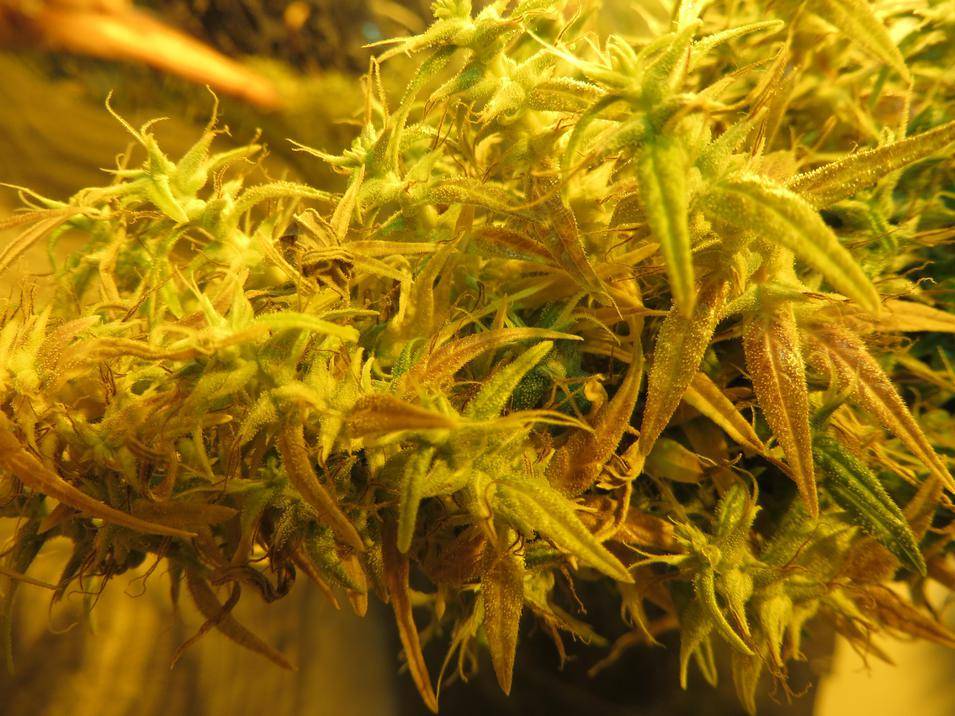
This has been growing with such small amounts of nitrogen that all the fan leaves, and a good many of the tiny bud leaves have died and fallen off or shriveled up. Part of the reason this is such an extreme example is that it is using the same nutrient solution for another plant that will be done at least 4 weeks earlier than this one will be. I didn't want to over fertilize it, so this one is on an extreme diet.
I'll let you know how it turns out.

ThaiBliss
This is a Thai dominant plant:
This has been growing with such small amounts of nitrogen that all the fan leaves, and a good many of the tiny bud leaves have died and fallen off or shriveled up. Part of the reason this is such an extreme example is that it is using the same nutrient solution for another plant that will be done at least 4 weeks earlier than this one will be. I didn't want to over fertilize it, so this one is on an extreme diet.
I'll let you know how it turns out.

ThaiBliss
Taking the Flush to the extreme. Anyone ever heard of Colombian Gold?
Some would say the 'gold' came from the sun when drying flowers in the sun, not 'flushing'.
some might say timing the feeding out for maximum senescence not flushing, but then again the old stories/timers from texada island, say one of the original seeds fellers{long gone} grew his plants hard yellow{like no one else on the island} and everyone always chomped at the bit to get a piece of his harvesto, cause it was always the strongest cleanest example of timwarp... The folks who have tryd and seen it dont right understand.. bravo thaibliss some colombian black tag your it....:dance013
Attachments
it was always the strongest cleanest example of timwarp... The folks who have tryd and seen it dont right understand..
Exactly. Strongest, cleanest (high) being the key words. I don't understand either, but have experienced it. I'd also concur with the feeding for maximum senescence. I'm doing both to a fault. I'm actually afraid it might die before it is at peak ripeness due to overdoing it. But, I would like to demonstrate an extreme example here.
I have heard of sun drying, but I don't think it was unique to Colombian Gold. I have also heard of girdling to get the gold (yellow) colors, as well as extreme high effects. Someone told me his stem spilt, he tided it back up and the plant turned gold/yellow colored. When he harvested, he found a worm was inside eating out the middle of the stem. He said it was the best weed he ever grew. As you can see, I have gotten the effect from flushing and using extremely light doses of all fertilizer, but especially nitrogen. 1 teaspoon of soybean meal per 55 gallons of water. Also a few tablespoons of high phosphorous, high potassium fertilizer from bird guano and fish emulsion. Also kelp and Epsom salt. In total, about 4 or 5 tablespoons per 55 gallons.
The plant I have is mainly Thai, but is suspected of having some Colombian in its heritage.

It should be ready for a preliminary, pre-cure, smoke test in about two months.
Best,
ThaiBliss
Here is my outdoor senescence example:
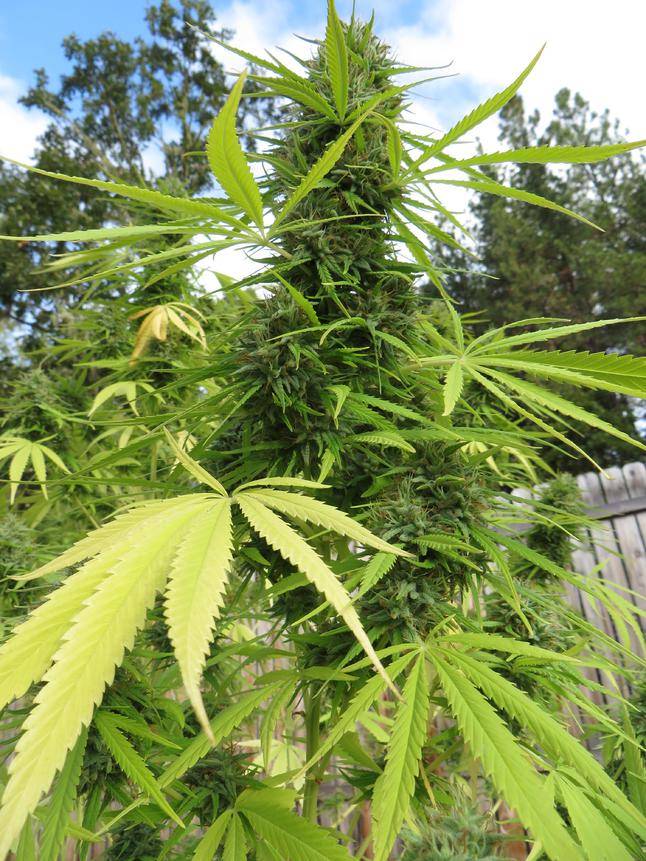
Not one drop of fertilizer since July 1st. Minimal fertilizer before July 1st. Just enough to keep it green while getting it big. It is in soil rich in compost, which normally has a nitrogen deficit. It took some manure and 5-1-1 fish emulsion at about 1/10th recommended strength to keep it from yellowing while growing. The plant was able to get about 10 feet tall. This is not an extreme example. It is a normal, for me, compromise between heft and quality.
ThaiBliss
Not one drop of fertilizer since July 1st. Minimal fertilizer before July 1st. Just enough to keep it green while getting it big. It is in soil rich in compost, which normally has a nitrogen deficit. It took some manure and 5-1-1 fish emulsion at about 1/10th recommended strength to keep it from yellowing while growing. The plant was able to get about 10 feet tall. This is not an extreme example. It is a normal, for me, compromise between heft and quality.
ThaiBliss
Here is my outdoor senescence example:
View Image
Not one drop of fertilizer since July 1st. Minimal fertilizer before July 1st. Just enough to keep it green while getting it big. It is in soil rich in compost, which normally has a nitrogen deficit. It took some manure and 5-1-1 fish emulsion at about 1/10th recommended strength to keep it from yellowing while growing. The plant was able to get about 10 feet tall. This is not an extreme example. It is a normal, for me, compromise between heft and quality.
ThaiBliss

 Not one drop of fertilizer yet in next sentence in soil rich compost
Not one drop of fertilizer yet in next sentence in soil rich compost  and almost a 10 foot plant ??? most fences are 6 feet tall due to local by laws hell pretty much law... Yet looking at your picture???? were you laying on the ground lmao cmon dude were stoners here not retards ,, here i show you a members tree must be 4 feet tall what you think ????
and almost a 10 foot plant ??? most fences are 6 feet tall due to local by laws hell pretty much law... Yet looking at your picture???? were you laying on the ground lmao cmon dude were stoners here not retards ,, here i show you a members tree must be 4 feet tall what you think ????most Organic mixtures tend to become N Def mid growth due to leaching and plant using it up this is why many out door growers tend to make teas and add it every week or bi weekly
We can sit here all day,, and bump heads . to me really i dont give a crap on your grow or anyone elses.
its how you want to do it fine
would you of gained more yield if plants were healthier with proper NPK through out with min yellowing probably thats a Fact most mountain jedi growers in cali would agree
Is your plants going to have less yield that you let her yellow off more or less like you mention not any food since july YES i can almost 100 percent say YES your plants are not going to yield as much
Many people tend to think that yellowing is normal and that thats what a plant suppose to do its a annual Right ??? Wrong
Lets be realistic here folks its applying the right amount of all essential elements so plant has no deficiencies
Were not talking keeping her dark green through out but keeping her green as long as you can That is the key
All your doing by letting her yellow off to soon is is pretty much everything
more yellowing on leafs = less photosynthesis , less energy less sugars and carbs that the plants makes.
So sure the plant uses up its bank reserves but has no power to replenish the bank so eventually in a short time it goes bankrupt,,, and thats not what you want
N is important PERIOD in all stages its the amount in every stage you have to be aware off
when i grew out door i used triple 19 same shit they use in corn fields 19- 19 -19 through out never a issue 800 pounds wet 200 pounds dry is what i am talking about No fucking around
Thai would love to see full picture of your almost 10 foot tall plant here a members on here incredible 8 pound plants for sure i cant get them that size due to LAT and short season Note how nice and healthy they are ???? thats the difference between a Jedi grower and a novice
Attachments
Your talking yield we are talking quality.....There is a balance to find when approaching senescence and yield/quality. We still want a plant to finish properly{It is just our properly finished line has shifted over the years due to experience} So is proper finish running your plants full of ferts to the very end to get a big yield? Experience has shown me there is a more enjoyable end product if we do not push our plant hard with ferts to the end, Yet walk the fine line you find over time and many grows growing /dialing the same clone. If you have ever had the opportunity to meet a grower who does this and is good at it. Well I see folks say, i don't care what the yield is i want to smoke a plant/bud like that how do i do it. So i do not mean to talk down to you or say your weed sucks. Experience tells me you do not even know enough to know you dont understand/ have experienced what we are talking about. Forget about money forget about yield and grow me a plant that is just about loving cannabis and having the best you can for yourself. That is a rare spot to find these days most grower i meet are focused on yield and money as number one. not me. grow on......
Your talking yield we are talking quality.....There is a balance to find when approaching senescence and yield/quality. We still want a plant to finish properly{It is just our properly finished line has shifted over the years due to experience} So is proper finish running your plants full of ferts to the very end to get a big yield? Experience has shown me there is a more enjoyable end product if we do not push our plant hard with ferts to the end, Yet walk the fine line you find over time and many grows growing /dialing the same clone. If you have ever had the opportunity to meet a grower who does this and is good at it. Well I see folks say, i don't care what the yield is i want to smoke a plant/bud like that how do i do it. So i do not mean to talk down to you or say your weed sucks. Experience tells me you do not even know enough to know you dont understand/ have experienced what we are talking about. Forget about money forget about yield and grow me a plant that is just about loving cannabis and having the best you can for yourself. That is a rare spot to find these days most grower i meet are focused on yield and money as number one. not me. grow on......
Can you cite any other plants that might grow in your garden that perform best (read: produce their best 'quality') when their nutritional needs are neglected? I can't.
Can you cite any other plants that might grow in your garden that perform best (read: produce their best 'quality') when their nutritional needs are neglected? I can't.
And the reverse is true..."perform best...when their nutritional needs are overdosed". Seldom are two extremes of anything the "best choice".
Lets examine nature. Can we agree that majority (if not all) of "plant available" nutrition is sourced from the soil? Can we also agree that rainfall (watering) can make a "good" crop--"great"...or make a "great" crop "good"...depending on when and how much. Rain before harvest is usually a "tear jerker"....just as a drought (water deficit) at certain times (crucial periods) can cause irreversible harm to the plant (stunt/runt).
I do know this, if I feed my tomato plants too much water they usually will burst/split on the vine. To get the best harvest from my apricot tree, I must remove about 1/3 of the fruit buds--if not the flavor is bland and lots of fruit dropping. Same with vineyards, they remove old wood each year--to make room for new wood.
That said...if one goal is to "mimic nature", then IMHO, imposing "tough love" is almost mandatory; some of the tools we cultivators have include: water excess/deficits, defoliation, temperature, soil, SAR, etc. But I understand the complication if one "never waters"...instead each "hydration" is a brew of nutes/enzymes/bacteria/boosters/enhancers--never just plain water; hard to withhold these without seeing a negative effect I guess. I "plain water" in between my feedings (mineral, enzyme, bacteria & fertility brews, as well as all my teas).
We are not talking over dosing our plants were taking about proper ratios through out all stages of plant growth till you chop
Vap i am talking quality, as well as Yield would you not agree that a healthy plant will obviously yield you more as well as have better quality ???
Do you also know that depletion of base nutrients in your soil creates Acidic soil ?? in time the loss of nutrient bases, without sufficient replacement by release from primary minerals, eventually leads to acid soils.
Soils are complex systems, and this fact holds true when considering the plant
availability of mineral nutrient elements to much of one nutrient can lock out other nutrients ,so its finding the right balance is what its all about
just like defoliation by removing leafs not only does it affect yield it slows plant bud set , plant can not get rid of toxins , co2 uptake is diminished , the list goes on ,
Yet many people think that it increases yield ??? its beyond me who comes up with these idiotic ideas obviously they were extremely stoned smoking some other persons weed lol
and who ever posted them leafy scraggy looking buds should be ashamed i really don't know what that was suppose to do
Here are some pics of grow the purps in leafs are from lights off temps plants were in low 50's extra plants thrown into flower 1 week veg under 48 watts then another week under 2000 watts then flip with cropping into second week of flower Sunblasters HO 1 3/4 2,5 oz dry per plant
Quality and quantity ppm levels never went over 650 ppm water ppm included in it veg nutes / bloom nutes 50 / 50 strength through out , Zinc foliage spray 3 ,4 week
last pic few days before chop plants were not even 15" tall and healthy 5 gallon totes packed with roots soils and roots came out as one
There are lots of great info in these forums but one must read thr them as many are rubbish all i say is do your best keep her green as along as you can for the best results i guarantee it
Flushing is only used as a last resort when your plants have issues other then that to think a grower grows his weed for months an to think that flushing is going to get rid of nutrients is just plain stupidity only thing your doing is taking away nutrients at its most crucial part of its life all flushing does is save you little money on food costs lol other then that in reality some nutrients are not mobile meaning you can not move them out of a plant N you can Calcium you can't etc
Vap i am talking quality, as well as Yield would you not agree that a healthy plant will obviously yield you more as well as have better quality ???
Do you also know that depletion of base nutrients in your soil creates Acidic soil ?? in time the loss of nutrient bases, without sufficient replacement by release from primary minerals, eventually leads to acid soils.
Soils are complex systems, and this fact holds true when considering the plant
availability of mineral nutrient elements to much of one nutrient can lock out other nutrients ,so its finding the right balance is what its all about
just like defoliation by removing leafs not only does it affect yield it slows plant bud set , plant can not get rid of toxins , co2 uptake is diminished , the list goes on ,
Yet many people think that it increases yield ??? its beyond me who comes up with these idiotic ideas obviously they were extremely stoned smoking some other persons weed lol
and who ever posted them leafy scraggy looking buds should be ashamed i really don't know what that was suppose to do
Here are some pics of grow the purps in leafs are from lights off temps plants were in low 50's extra plants thrown into flower 1 week veg under 48 watts then another week under 2000 watts then flip with cropping into second week of flower Sunblasters HO 1 3/4 2,5 oz dry per plant
Quality and quantity ppm levels never went over 650 ppm water ppm included in it veg nutes / bloom nutes 50 / 50 strength through out , Zinc foliage spray 3 ,4 week
last pic few days before chop plants were not even 15" tall and healthy 5 gallon totes packed with roots soils and roots came out as one
There are lots of great info in these forums but one must read thr them as many are rubbish all i say is do your best keep her green as along as you can for the best results i guarantee it
Flushing is only used as a last resort when your plants have issues other then that to think a grower grows his weed for months an to think that flushing is going to get rid of nutrients is just plain stupidity only thing your doing is taking away nutrients at its most crucial part of its life all flushing does is save you little money on food costs lol other then that in reality some nutrients are not mobile meaning you can not move them out of a plant N you can Calcium you can't etc
Attachments
HerBnGorE(illa)
Member
Dr fever...
....sorry to go off subject here, but what is the reason for the zinc foliage spray you speak of for week 3-4?
....sorry to go off subject here, but what is the reason for the zinc foliage spray you speak of for week 3-4?
http://www.kindgreenbuds.com/marijuana-grow-guide/spray-n-grow/Dr fever...
....sorry to go off subject here, but what is the reason for the zinc foliage spray you speak of for week 3-4?
there are many reasons to use Spray n grow foliage and i can agree that it does make a difference in plant health yield and quality been using it for years
A micronutrient complex, cultured in a water base, that acts as a biocatalyst. A professor at a major agricultural university stated that Spray-N-Grow is a balanced system of micronutrients reacting synergistically … all components working together harmoniously that in effect perform as a single active ingredient. Spray-N-Grow activates dormant microorganisms in the soil, enabling plants to better utilize nutrients. It concentrates phosphate at the bud tips and causes the plant to produce more blooms and set more fruit; it reconditions the soil and helps restore it back to its Natural fertility by restoring microbial activity; and it also relieves built-up stress conditions caused by over fertilization, salt build-up and petrochemical use.
Increases yield by weight and fruit size
Increases blooming and fruit set
Increases growth rate for earlier development
Increases brix, dry matter, vitamin C and mineral content
Improves root development for better nutrient and water uptake
Increases microbial activity in soil to restore a more natural fertility
Relieves salt stress situations caused by over fertilization
Prolongs storage life of fruits, vegetables and flowers
Zinc plays an important role in many biochemical reactions within the plants. Plants such as
maize and sorghum and sugarcane shows reduced photosynthetic carbon metabolism due to
zinc deficiency. Zinc modifies and/or regulates the activity of cabonic anhydrase, an enzyme
that regulates the conversion of carbon dioxide to reactive bicarbonate species for fixation to
carbohydrates in these plants. Zinc is also a part of several other enzymes such as superoxide
dismutase and catalase, which prevents oxidative stress in plant cells. Following are the
various other roles of zinc in plants;
1. production of auxin, an essential growth hormone
2. regulates starch formation and proper root development
3. formation of chlorophyll and carbohydrates
4. enable plants to withstand lower air temperatures
5. helps in the biosynthesis of cytochrome; a pigment, and maintains plasma
membrane integrity, and synthesis of leaf cuticle.

